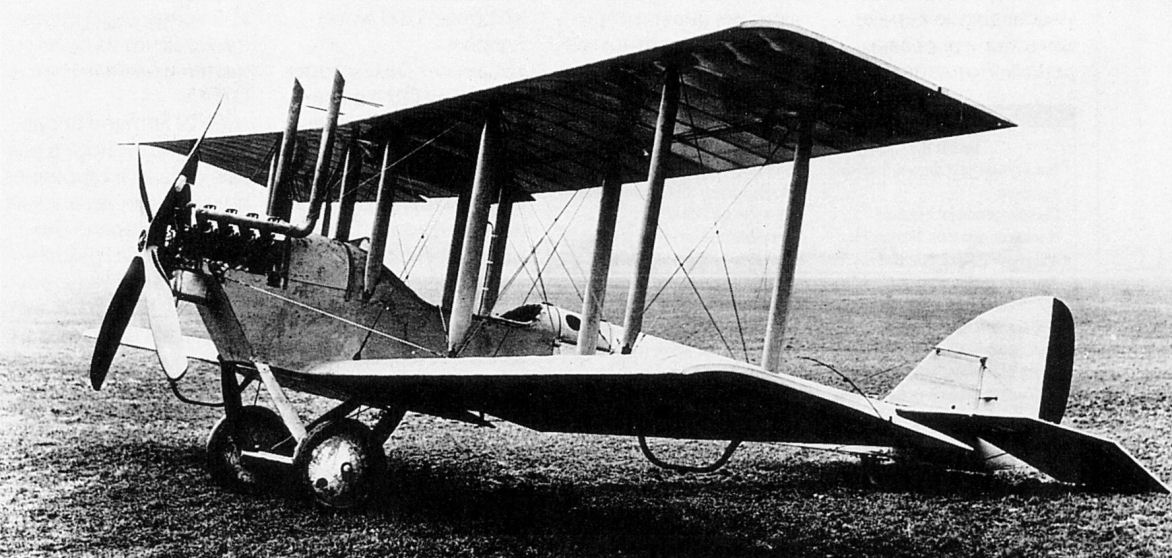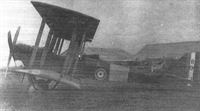
Описание
Страна : Великобритания
Год : 1917
Двухместный учебно-тренировочный самолет
Airco (de Havilland) D.H.6
Airco (de Havilland) D.H.6, разработанный в 1916 году как учебный самолет, представлял собой биплан обычной конструкции, хвостовое оперение имело полотняную обшивку на каркасе из стальных трубчатых рам с деревянными нервюрами. Шасси из-за частых поломок при неосторожном пилотировании было усилено и включало подкрыльевые костыли для защиты концевой части крыла при неудачной посадке. Благодаря расположению инструктора и ученика в общей кабине, они могли общаться между собой в полете.
Испытания показали, что D.H.6 был весьма легок в управлении и настолько устойчив, что его устойчивость даже пришлось снижать, чтобы ученики были готовы к полетам на менее "дружественных" самолетах, на которые им предстояло пересесть позже. В начале 1917 года самолет запущен в серию и выпущен в количестве 2300 экземпляров. Они служили в Королевском воздушном корпусе и Королевских ВВС до тех пор, пока не были заменены на Avro Type 504K. В дополнение к самолетам, построенным фирмой-разработчиком, D.H.6 выпускал ряд субподрядчиков.
Обозначение D. Н.6А неофициально было присвоено в конце 1918 года модификации с уменьшенной до 38,37 м2 площадью крыльев и двигателем Curtiss OX-5.
С марта 1918 года машины D.H.6, принадлежавшие Королевскому воздушному корпусу, поступили на эксплуатацию в Авиационную службу ВМФ Великобритании и ВМС США, где использовались для противолодочного патрулирования. Американцы совершали на них полеты над побережьем Ирландии. Патрулирование осуществлялось с одним членом экипажа и бомбовой нагрузкой в 45 кг.
Когда закончилась война, в Королевских ВВС оставалось свыше 1000 самолетов D.H.6. Многие из них были проданы гражданским покупателям по остаточной стоимости. Шесть десятков самолетов в 1921 году было построено по лицензии испанской фирмой "Hispano-Suiza SA". Они использовались в испанских ВВС в качестве учебных машин.
ТАКТИКО-ТЕХНИЧЕСКИЕ ХАРАКТЕРИСТИКИ
Airco (de Havilland) D.H.6
Тип: двухместный учебно-тренировочный самолет
Силовая установка: рядный поршневой двигатель RAF1 мощностью 90 л. с. (67 кВ), некоторые машины оснащались рядным двигателем Renault мощностью 80 л. с. (60 кВт) или двигателем Curtiss OX-5 Vee мощностью 90 л. с. (67 кВт)
Летные характеристики: (с двигателем RAF 1) максимальная скорость 113 км/ч на уровне моря; максимальная скороподъемность 69 м в мин на уровне моря; набор высоты 1980 м за 29 с; продолжительность полета 2 ч 45 мин
Масса: пустого 662 кг; максимальная взлетная 919 кг
Размеры: размах крыла 10,95 м; длина 8,32 м; высота 3,29 м; площадь крыла 40,53 м2
Вооружение: до 45 кг бомб под нижним крылом при решении задач противолодочного патрулирования
Описание:
- Airco (de Havilland) D.H.6
- Flight, August 1920
THE "ALULA" WING: A Suggested Application
Фотографии
-
Мировая Авиация 19
One of the two D.H.6 prototypes, with traditional de Havilland rudder.
-
Air Enthusiast 1996-07 / C.Ashworth, P.Green - Bournemouth Bases
Airco-built DH.6 B304x. Note the fuselage band.
-
Aeroplane Monthly 1990-03 / Personal album. Civil
Регистрационный номер: K-100, G-EAAB Pictured at Hendon in the summer of 1919 is the first aeroplane in Britain, and possibly the world, to receive a civil registration. The K- system of registration was used for just one month from May 1919, beginning with K-100 and ending with K-175. K-100 was allocated to the D.H.6 seen here being started with the aid of a Hucks starter. Generally flown at Hendon by Capt Gerald Gathergood, the D.H.6 was re-registered G-EAAB when the new system was introduced on July 22, 1919.
-
Aeroplane Monthly 1990-12 / Personal album. Civil
Регистрационный номер: G-EAUS Blackpool Flying Services’ Renault-engined D.H.6 G-EAUS flying off Morecambe Sands during the early Twenties.
-
Flight 1921-06 / Flight
FLYING IN "THE ISLAND": On Thursday of last week the Brompton Motor Company inaugurated joyriding in the Isle of Wight, where they will continue during the summer. The photograph on the left shows two of the machines on the sands between Ryde and Seaview, and on the right are seen, standing by the D.H. 6, Lieut.-Col. A. T. C. Veasey, and Capt. R. E. Dean, the latter one of the pilots of the firm.
-
Flight 1924-03 / Flight
Регистрационный номер: G-EARL A Giant Seaplane: The four-engined "Atalanta'' flying boat was designed by the Fairey Aviation Company and built by the English Electric Company. It is fitted with four Rolls-Royce "Condor" engines. A good idea of size is provided by the D.H.6 standing next to the "Atalanta."
Другие самолёты на фотографии: Fairey N.4 Atalanta - Великобритания - 1923
-
Flight 1920-04 / Flight
The line-up for the cross-country race at Bournemouth on Easter Monday. From left to right the machines are Caudron G.3 (70 h.p. Renault), F.E.2b (160 h.p. Beardmore), De H.6 (80 h.p. Renault), Avro (110 h.p. Le Rhone), Avro (110 h.p. Le Rhone), Avro (110 h.p. Le Rhone). The course was a double-circuit from the Bournemouth Aerodrome, round Christchurch Priory, a distance of 20 miles.
Другие самолёты на фотографии: Avro Avro 504 - Великобритания - 1913Caudron G.3 - Франция - 1913RAF F.E.2 - Великобритания - 1914
-
Flight 1920-08 / Flight
THE "ALULA" WING: Our photo, shows an experimental machine, built by the Blackburn Co. and flown by their pilot, Capt. Clinch, for ascertaining full-size figures for the wing. The high position of the plane is used to get it out of the propeller slip stream
-
Jane's All the World Aircraft 1980 / Encyclopedia of Aviation - Aircraft A-Z - v1
Observer's cockpit of a D.H.6 specially equipped with Marconi radio
-
Aeroplane Monthly 1974-09 / Personal album
Capt Duttson with the results of a downwind landing in a Grahame-White-built D.H.6 "Clutching Hand" in September 1917.
-
Aeroplane Monthly 1979-06 / Personal album
"Not a bad landing" is the comment written alongside this shot of an A-serialled D.H.6 from another batch built by the Grahame-White Aviation Co Ltd. Someone with a sense of humour has painted the name “Lightning” above the numeral 3 on the aircraft’s nose (top speed was 70 m.p.h. with the 90 h.p. RAF IA engine). A man is in the process of climbing the tree, and it also seems that the pilot is still in residence.
-
Aeroplane Monthly 1974-04 / Personal album
Регистрационный номер: C7321 De Havilland D.H.6 C7321, built by Ransome, Sims & Jeffries of Ipswich, which Lt Trask of 52 Sqn RAF landed in a tree on the edge of Catterick Airfield, Yorkshire, in May 1918.
-
Aeroplane Monthly 1985-04 / Personal album
Регистрационный номер: C7857 Grahame-White built Airco D.H.6 C7857 reposes in a hedge after a night landing accident.
-
Aeroplane Monthly 1974-04 / Personal album
Another D.H.6, this time from 127 Sqn, crashed into Catterick Bridge by Lt Sloan, with Lt Gates also aboard, June 1918. Another D.H.6 can be seen flying across in right picture.
-
Aeroplane Monthly 1974-04 / Personal album
These two D.H.6s, flown by Lts Robertson and Gages, both of 52 Sqn, collided in mid-air over Catterick in June 1918.
-
Aeroplane Monthly 1979-06 / Personal album
Регистрационный номер: B2762 Airco D.H.6 B2762 after attempting an unorthodox entry into a hangar. Designed in 1916 to meet the RFC’s urgent need for a primary trainer, the D.H.6 was an unlovely aeroplane to behold, but its simple construction and angular lines made it ideal for mass production and quick repair. The type remained in service until 1919, when it was declared obsolete.
-
Air-Britain Aeromilitaria 1987-04
Регистрационный номер: B2717 The remains of Airco D.H.6 B2717 after it had used a hangar as an aid to braking, believed at Catterick in 1917
-
Aeroplane Monthly 1979-06 / Personal album
Another unfortunate D.H.6, this time C783?, built under licence by the Grahame-White Aviation Сo Ltd at Hendon. The three fuselage bands are the markings of a training squadron.
- Фотографии

















